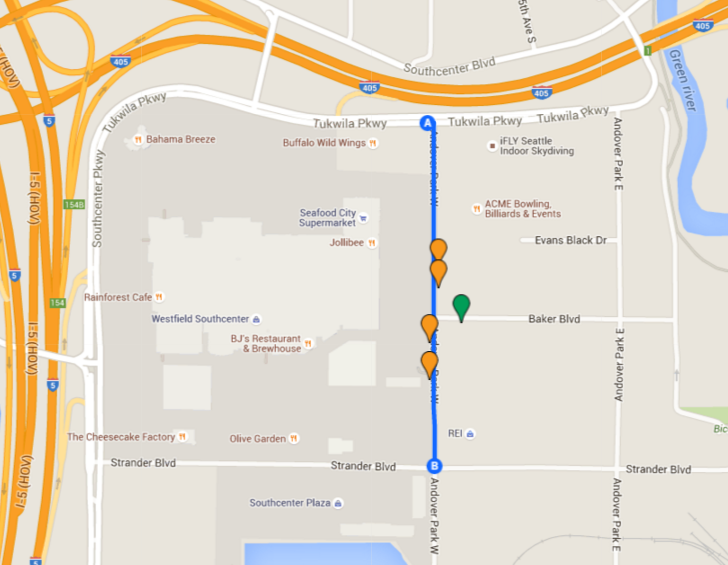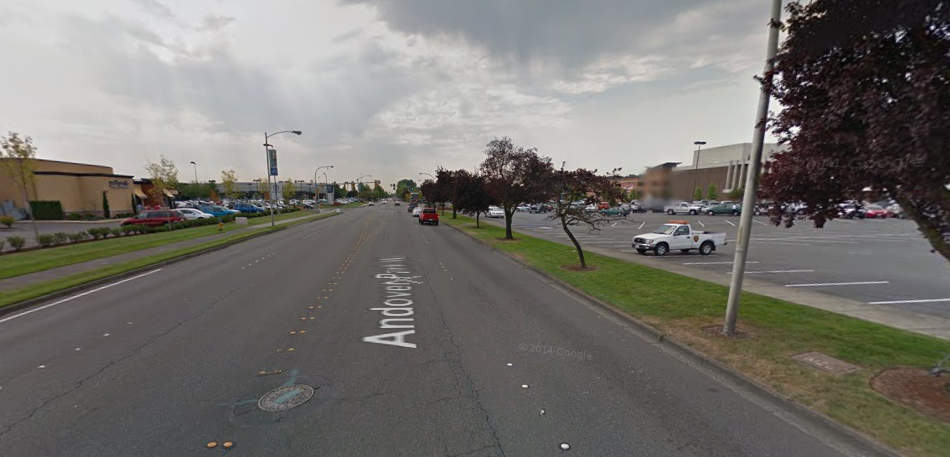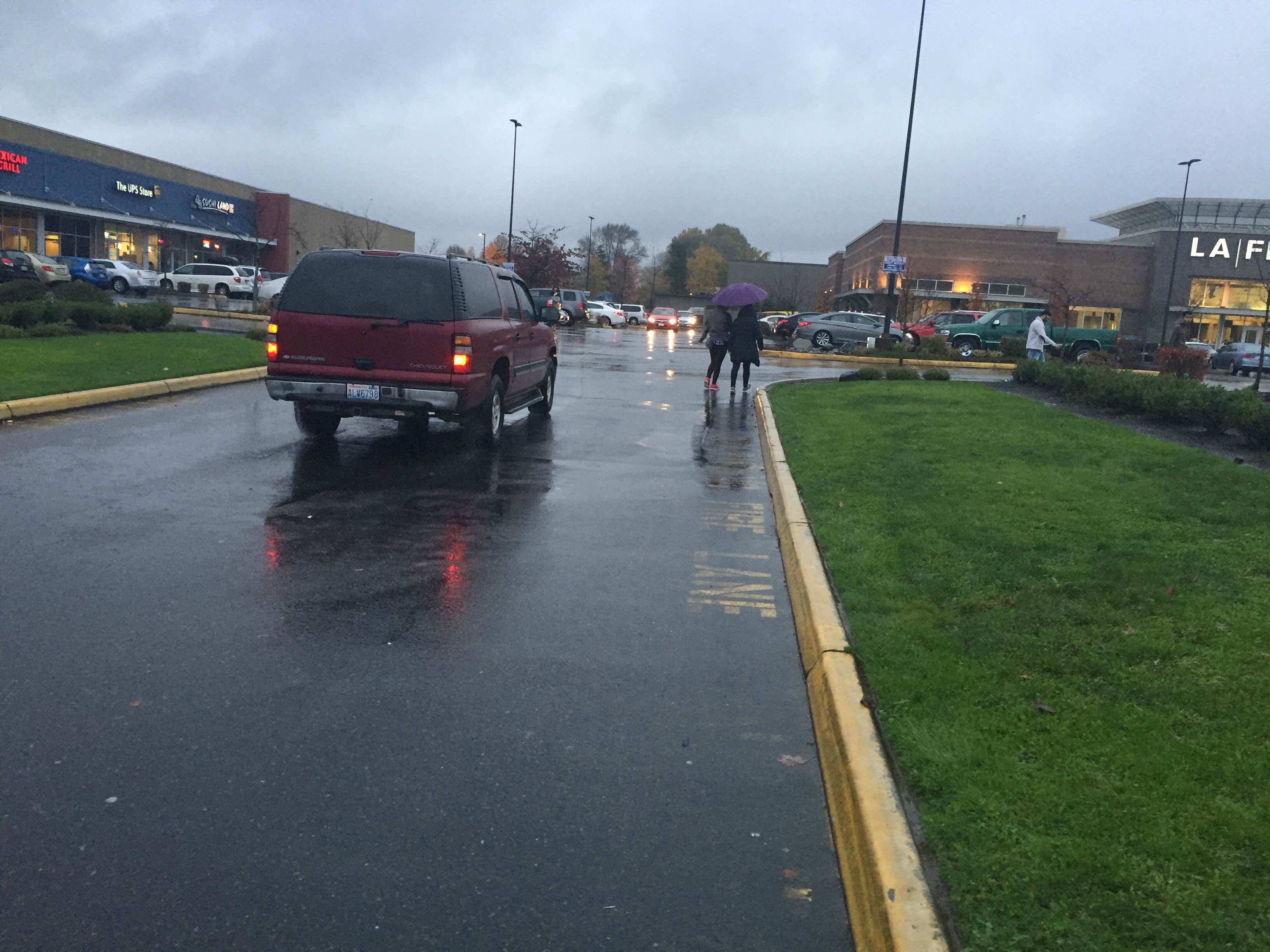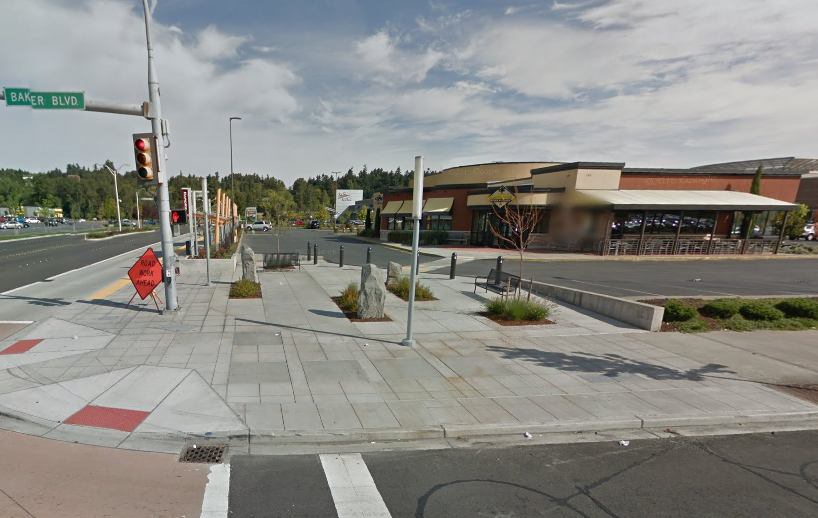The City of Tukwila has delivered a series of pedestrian and transit facility improvements near Westfield Southcenter, a major regional shopping mall. The bulk of the improvements are focused on Andover Park West between Tukwila Parkway and Strander Boulevard. Andover Park West is a primary arterial in Tukwila’s commercial core. On the west side of the street the arterial provides key access points to the shopping mall, while on the east side of the street the arterial provides access to chain stores, dealerships, and other commercial businesses.

The City packaged a mix of street improvements, new transit facilities, and replacement of local water mains as part of the overall Tukwila Transit Center Project. Specifically, the improvements include:
- Installation of bus shelters, landscaping, waiting areas, and treated pavement
- Widening of the right-of-way
- Rechannelization of the street
- Addition of landscaped medians
- Installation of street lighting, security cameras, and traffic loops
- Replacement of sidewalks, curbs, gutters, and accessible ramps
- Replacement of a water main.
Andover Park West is one of the busiest streets in Southcenter due to its proximity to the interstate highways and use as a thoroughfare to commercial properties flanking it. The original street consisted of two through lanes in both directions (2 + 2). Without turn pockets and pullouts for buses, the busy street and fast speeds had long posed serious problems for buses that stop in-street, people on foot, and those driving to and from local businesses. Tukwila sought to improve the situation by widening the right-of-way in targeted ways. This included the addition of a center lane for turn pockets and landscaped median islands as well as bus pullouts in each direction near Baker Boulevard.


The new configuration is arguably a safer design for a variety of reasons.
Firstly, turn pockets ensure that motorists have a place of refuge in the middle of the street. This makes turns in and out of parking lots simpler. The prior configuration could have required that three lanes of traffic remain unobstructed long enough for a motorist to traverse all of them in order to get out of a parking lot. Unsurprisingly, this situation can lead to many motorists “gunning it”, which in some circumstance can lead to poor consequences. So this should be seen as a positive change for all users of the right-of-way.
Secondly, landscaped medians reduce the number of locations where motorists can sit in the middle of the street and introduce an “obstacle” to the streetscape. It’s widely understood that treelined streetscapes and street furniture can change the “window” in which motorists see themselves and others. They present immediate obstacles to the space for motorists to react to, which slows down speeds. Admittedly, the number of landscaped medians are few, but they should still help to control speed.
Thirdly, with buses stopping at pullouts instead of in-street, the threat of motorists weaving and rear-ending them should be largely eliminated.
Finally, pedestrians now have wider sidewalks to use. The previous sidewalks were narrow and often meant that people could not walk side by side. Pedestrians should now have much more room both on the sidewalk and between them and vehicles, which is perhaps the most important benefit to sidewalk widening.
The transit component to all of this is central. Bus stops on Andover Park West have proven to be highly popular with local employees and shoppers for years. During day-time hours, it’s typical to see dozens of riders of Routes 128, 150, and 156 and RapidRide F Line board and disembark buses as they pass through. Recognizing this, Tukwila made targeted transit improvements with these additions:
- Multiple bus bays with seating, windshields, and decorative canopies
- Real-time arrival signs, bus bay signage, and signature signage to mark the location of the transit facilities
- Bicycle storage and receptacle bins
- Wider sidewalks, painted concrete, and tactile surfaces near platform edges
- Comprehensive lighting systems, security cameras, and retained landscaping areas.
The overall design feels much more comfortable and safe for riders compared to the old design. Sitting at the stops (instead of on walls) is now a real option for most riders thanks to ample seating. Multiple bays spread out the transit facilities so that riders don’t feel like they have to bunch into one area. The bus pullout puts fast moving vehicles further away, reducing noise and the stress that cars can pose to riders waiting at stops. And the generous amount of lighting throughout the transit facilities means that riders are better seen by all, increasing the general perception of safety.



The new transit facilities required one bus stop to move a few blocks north. The old northbound stop at Andover Park West and Strander Boulevard was moved to the north side of the Andover Park West and Baker Boulevard intersection. This was a practical change because it places the stop much closer to the shopping mall entrance. Safe pedestrian facilities have been in place for years to guide shoppers and employees toward the complex’s center. The bus stop changes also make it easier for riders to transfer to eastbound Routes 128 and 906 on the south side Baker Boulevard at Andover Park West. (That stop received some treatments similar to those on Andover Park West.)
Riders will note that the transit facilities consist of two sets of bus bays: one for regular routes and one for RapidRide F. The RapidRide F bays come with all of the standard bells and whistles for off-board payment, stop map, real-time arrival signs, and service branding. Buses accordingly stop at their respective bays only.
Tukwila has certainly made huge strides to improve the experience of pedestrians and transit users, but there’s only so much that the City can do on its own. Older developments still prevail throughout the area, and many of those are not as oriented to people on foot. Within mere feet of the eastern transit bays of Andover Park West, many businesses remain only partially accessible to those who walk or take transit, despite recent additions of walking facilities.


Unfortunately, the prevailing suburban development pattern largely focuses buildings in the middle of parking lots. Those are obstacles to pedestrians to be sure, but it is only reinforced with perimeter landscaping that dissuades pedestrians from taking short cuts and the general lack of direct paths dedicated to them. We know that pedestrians will naturally try to take the shortest distance between two points wherever possible.
This is a very real problem that requires special attention to fix. Property owners and the City would do well to learn from the desire lines of pedestrians, and accordingly respond by retrofitting sites with them in mind. In the meantime, people will continue to walk on drive aisles or landscaping, options that are neither safe nor desirable.
Stephen is a professional urban planner in Puget Sound with a passion for sustainable, livable, and diverse cities. He is especially interested in how policies, regulations, and programs can promote positive outcomes for communities. With stints in great cities like Bellingham and Cork, Stephen currently lives in Seattle. He primarily covers land use and transportation issues and has been with The Urbanist since 2014.


